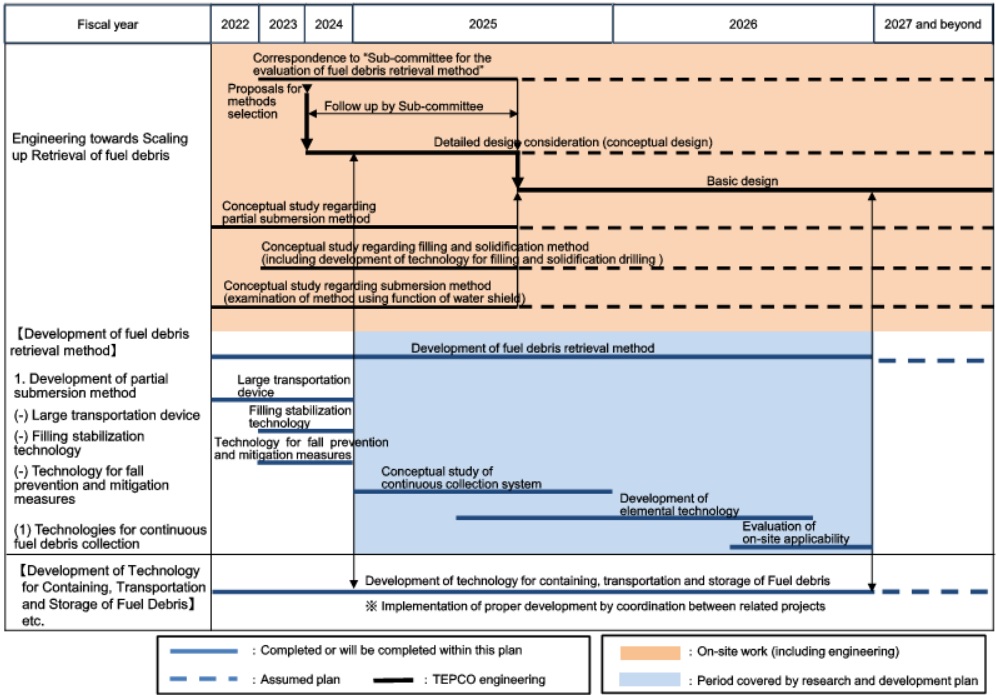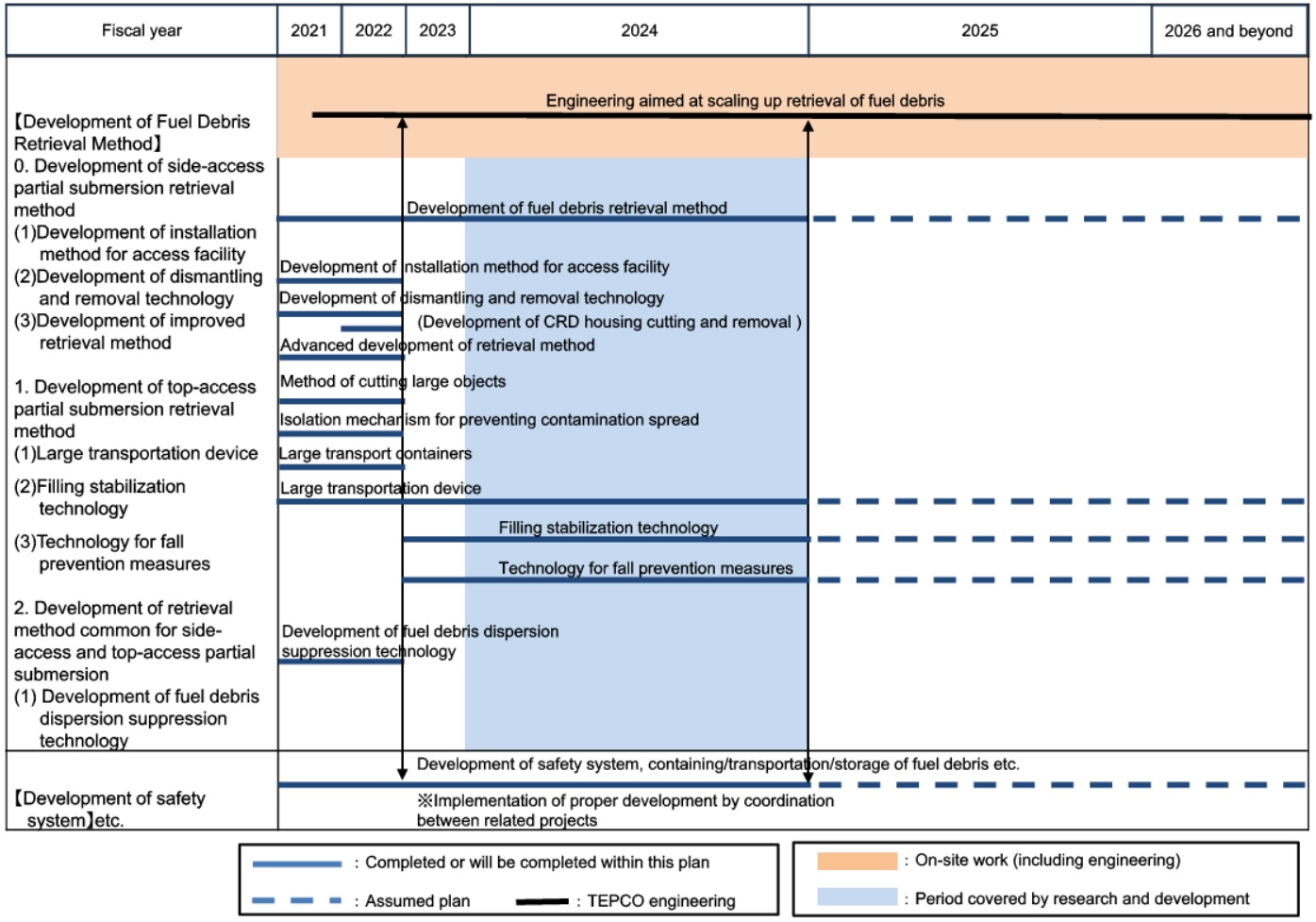Development of method and system for fuel debris retrieval
R&D efforts (Application development linked to plant applications and actual use)
Ongoing projects
Development of Fuel Debris Retrieval Method (Project of Decommissioning and Contaminated Water Management)
Summary
Towards scaling up retrieval of fuel debris and internal structures, development of elemental technology and tests necessary for retrieval method feasibility shall be conducted and on-site applicability shall be evaluated.
Action items
- Development of Partial Submersion Method
(1) Development of technologies for continuous fuel debris collection
Implementation plan
Source: FY 2025 Research and Development Plan for Decommissioning
(METI, Secretariat of the Team for Countermeasures for Decommissioning and Contaminated Water Treatment (February 29, 2025)) (PDF page 9-10)
Development of Technologies for Work Environmental Improvement in Reactor Building (Project of Decommissioning and Contaminated Water Management)
Summary
Towards the scaling up retrieval of fuel debris and internal structures, technology development related to work environmental improvement shall be implemented as it is necessary for the safe and efficient work inside the Reactor Building(R/B) where there are still places with the damage status caused by the accident is unknown and the dose rate is still high.
Action
-
- Development of Systems for Remote Monitoring and Removal Operation for Removal of PCV Penetration Pipes etc.
Implementation plan
Source:FY 2025 Research and Development Plan for Decommissoning
(METI, Secretariat of the Team for Countermeasures for Decommissioning and Contaminated Water Treatment (February 24, 2025)) (PDF page 2-3)
Results & performance by fiscal year
- FY 2024
- FY 2023
- FY 2022
- FY 2021
Development of Technologies for Impact Assessment due to Dust Dispersion (Project of Decommissioning and Contaminated Water Management)
Summary
Towards scaling up retrieval of fuel debris, necessary for ensuring safety of retrieval works technology shall be developed for assessment of dust dispersion impact.
Action
- Development of technologies for impact assessment due to dust dispersion
(1) Implementation of Test on Dust Dispersion Rate Data Acquisition Assuming the Environment during Fuel Debris Processing
(2) Implementation of Tests to Understand the Impact on the Leak Pass Factor of Dust During Fuel Debris Processing
Implementation plan
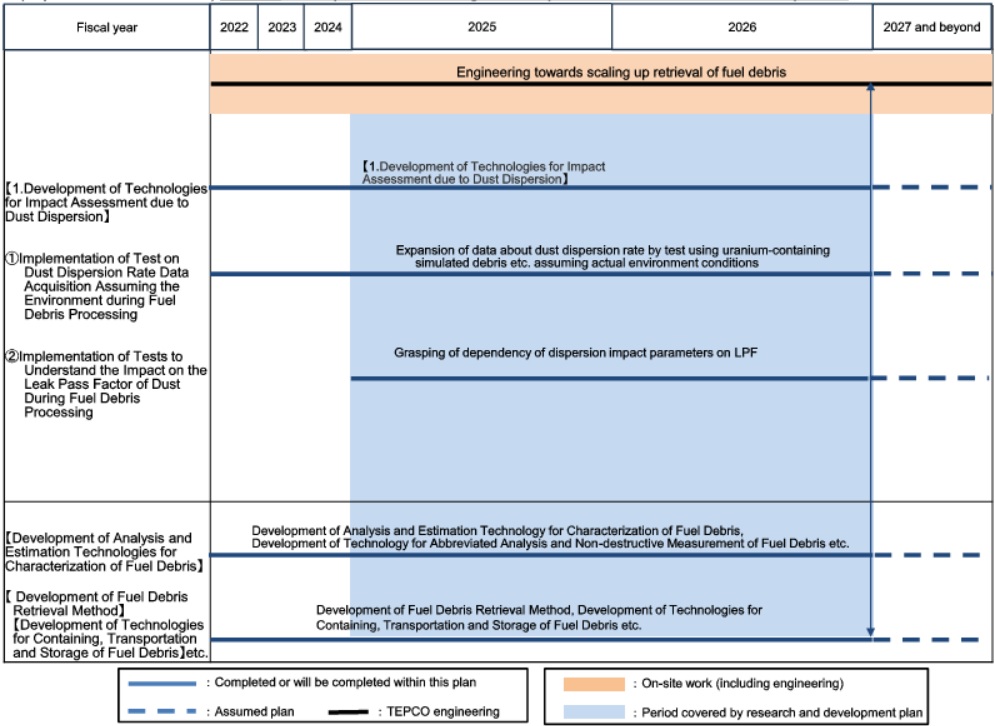
Source: FY 2025 Research and Development Plan for Decommissioning
(METI, Secretariat of the Team for Countermeasures for Decommissioning and Contaminated Water Treatment (February 24, 2025)) (PDF page 13-14)
Technology Development of Analytical Method for Exposure Dose Evaluation (Project of Decommissioning and Contaminated Water Management)
Summary
Towards scaling up retrieval of fuel debris and internal structures, the elemental technologies to ensure safety during these operations shall be developed and conducted the tests.
Action
- Technology development for analytical method for exposuredose evaluation
(1) Technology Development for Measuring and Evaluating Internal Exposure Dose
(2) Development of Technologies for Measuring and Evaluating Body Contamination
Implementation plan
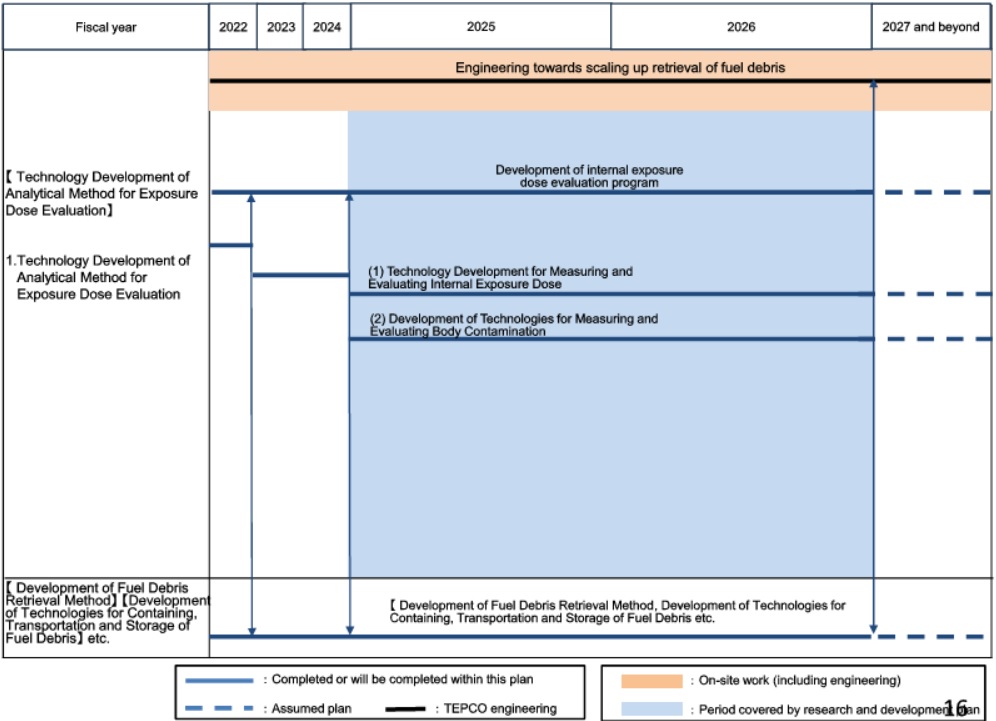
Source: FY 2025 Research and Development Plan for Decommissioning
(METI, Secretariat of the Team for Countermeasures for Decommissioning and Contaminated Water Treatment (February 24, 2025)) (PDF page 15-16)
Development of Assistive Technologies for Integration Management of Decommissioningof the Fukushima Daiichi Nuclear Power Station (Project of Decommissioning and Contaminated Water Management)
Summary
Technologies related to the assistive system necessary for smooth integration management of decommissioning of the Fukushima Daiichi NPS (1F) including scaling up retrieval of fuel debris and internal structures shall be developed.
Action
- Study of overall concept of assistive system for integration management
- Development of technologies for integration management using digital technologies
Implementation plan
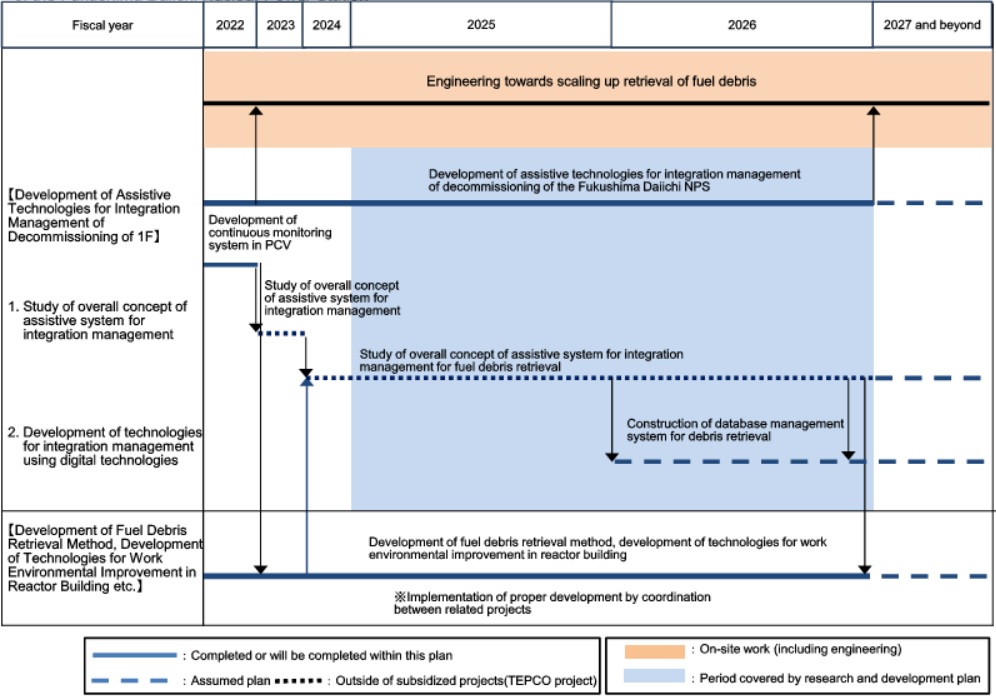
Source: FY 2025 Research and Development Plan for Decommissioning
(METI, Secretariat of the Team for Countermeasures for Decommissioning and Contaminated Water Treatment (February 24, 2025)) (PDF page 19-20)
Results & performance by fiscal year
- FY 2022
- FY 2021
Switch button
Predecessor project (1): Development of Fuel Debris Retrieval Method (Project of Decommissioning and Contaminated Water Management)
Summary
Towards scaling up retrieval of fuel debris and internal structures, development and test shall be conducted for elemental technology required for feasibility of works regarding retrieval method, and on-site applicability shall be evaluated.
Action items
- Development of Top-Access Partial Submersion Retrieval Method
(1) Large Transportation Device
(2) Filling Stabilization Technology
(3) Technology for Fall Prevention Measures
Implementation plan
Source: FY 2024 Research and Development Plan for Decommissioning
(METI, Secretariat of the Team for Countermeasures for Decommissioning and Contaminated Water Treatment (February 29, 2024)) (PDF page 10-11)
Results & performance by fiscal year
- FY 2024
- Status of progress at the end of February 2025 (METI, Secretariat of the Team for Countermeasures for Decommissioning and Contaminated Water Treatment (February 24, 2025)) (PDF page 53-54 Japanese)
- FY 2023
- FY 2022
- FY 2021
Predecessor project (2): Safety system (Project of Decommissioning and Contaminated Water Management)
Summary
For the scaling up retrieval of fuel debris and internal structures, it shall be implemented the development and tests of essential technologies which will be necessary for ensuring the safety during on-site works.
Action
- Development of Liquid Processing System
(1) Development of α-nuclides Removal Technology
(2) Development of Secondary Waste Processing Technology
(3) Development of Technologies for Improvement of Analysis Acceleration and Efficiency for Nuclear Fuel Materials and Elements etc. with Difficulty to Analyze - Acquisition of Dust Dispersion Rate Data
Implementation plan
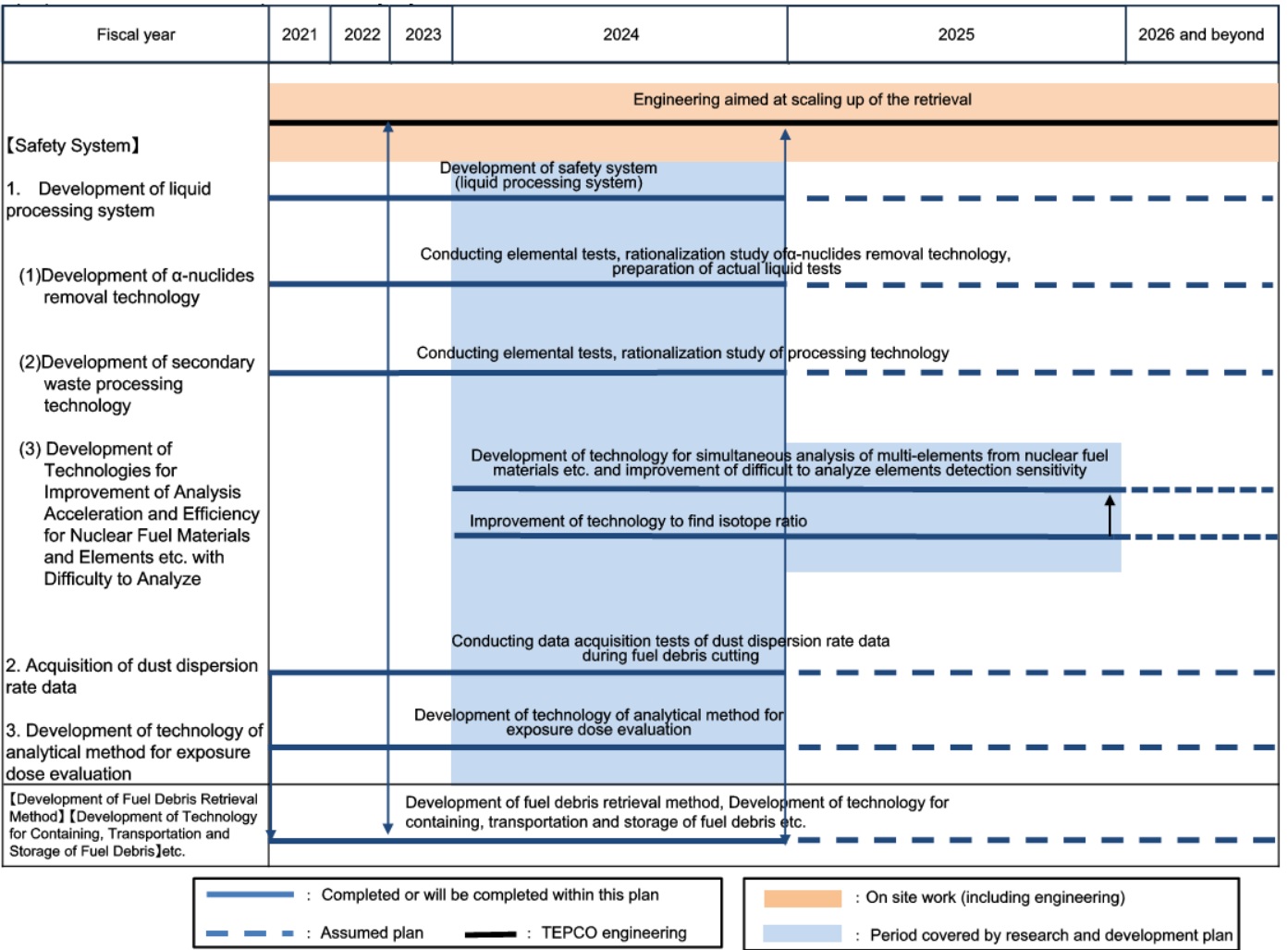
Source: FY 2024 Research and Development Plan for Decommissioning
(METI, Secretariat of the Team for Countermeasures for Decommissioning and Contaminated Water Treatment (February 29, 2024)) (PDF page 12-14)
Results & performance by fiscal year
- FY 2024
- FY 2023
- FY 2022
- FY 2021
Predecessor project (3): Development of Technologies for Retrieving Fuel Debris and Internal Structures (Project of Decommissioning and Contaminated Water Management)
Summary
We develop elemental technologies required for equipment/device/system for for the further expansion of retrieval of fuel debris and internal structures, and for ensuring safety during the work for retrieval of fuel debris based on development results so far, and perform the test.
Action items
- Development of retrieval method of fuel debris
- Development of technologies for handling fuel debris
2.1 Development of dust collection/collection system of fuel debris in PCV
2.2 Development of cleaning/processing technologies of fuel debris and deposits in liquids
2.3 Survey on technologies for sorting out fuel debris and waste - Development of technologies for ensuring safety during the work for retrieval of fuel debrisl
3.1 Development of elemental technologies relating to containment functions
3.2 Development of elemental technologies for criticality prevention and monitoring
Implementation plan
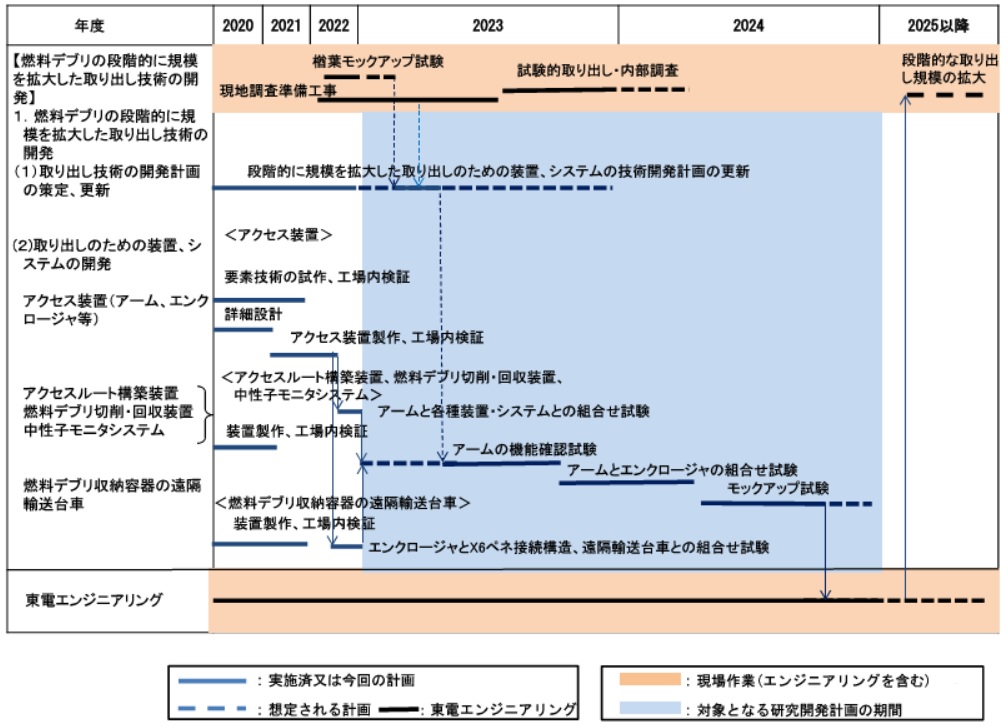
Source: FY 2020 Research and Development Plan for Decommissioning
(METI, Secretariat of the Team for Countermeasures for Decommissioning and Contaminated Water Treatment (February 27, 2020)) (PDF page 12)
Results & performance by fiscal year
- FY 2020
Predecessor project (4): Development of Technologies for Retrieving Fuel Debris and Internal Structures (Project of Decommissioning and Contaminated Water Management)
Summary
We develop elemental technologies required for equipment/device/system for retrieval of fuel debris and internal structures, and for ensuring safety during the work for retrieval of fuel debris based on development results so far, and perform the test.
Action items
- Development of retrieval method of fuel debris
- Development of technologies for handling fuel debris
2.1 Development of dust collection/collection system of fuel debris in PCV
2.2 Development of cleaning/processing technologies of fuel debris and deposits in liquids
2.3 Survey on technologies for sorting out fuel debris and waste - Development of technologies for ensuring safety during the work for retrieval of fuel debrisl
3.1 Development of elemental technologies relating to containment functions
3.2 Development of elemental technologies for criticality prevention and monitoring
Implementing organizations
Implemented by IRID, ONET TECHNOLOGIES, Joint Stock Company "TENEX".
Implementation plan
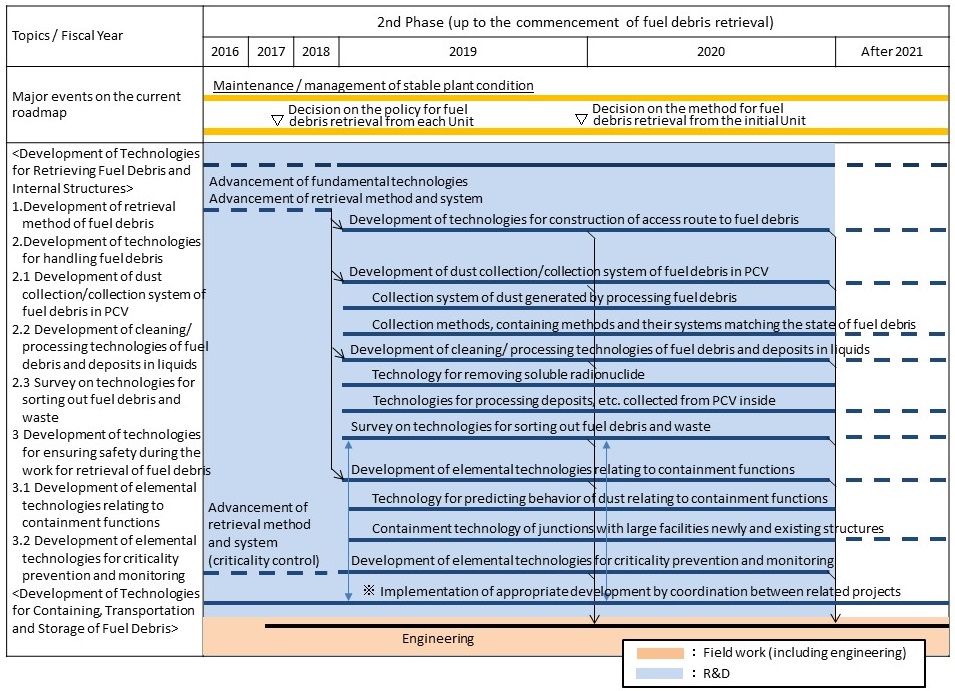
Source: FY 2019 Research and Development Plan for Decommissioning
(METI, Secretariat of the Team for Countermeasures for Decommissioning and Contaminated Water Treatment (February 28, 2019)) (PDF page 12)
Results & performance by fiscal year
- FY 2019
Predecessor project (5): (2nd stage) Advancement of Retrieval Method and System of Fuel Debris and Internal Structures (Project of Decommissioning and Contaminated Water Management)
Summary
In technologies for advancement of retrieval method and system of fuel debris and internal structures, we develop technologies to solve the problem extracted as aresult of concept study, and carry out elemental test as needed.
Action items
- Technology development about containment function
- Technology development for ensuring of containment function
- Technology development about exposure reduction
- Technology development about collection/removal of dust derived from fuel debris
- Technology development for reduction/removal of radioactive substance in air
- Technology development for reduction/removal of radioactive substance in water
- Study on monitoring system of α nuclide by fuel debris retrieval
- Concept study on detection technology and system of α nuclide in air and making of development plan
- Concept study on detection technology and system of α nuclide in water and making of development plan
- Technology development about establishment of criticality control method
- Technology development for measurement of subcriticality and subcriticality monitoring
- Technology development about detection of recriticality
- Development of criticality prevention technologies
- Optimization study on safety ensuring of method and system
Implementing organizations
Implemented by IRID.
Implementation plan
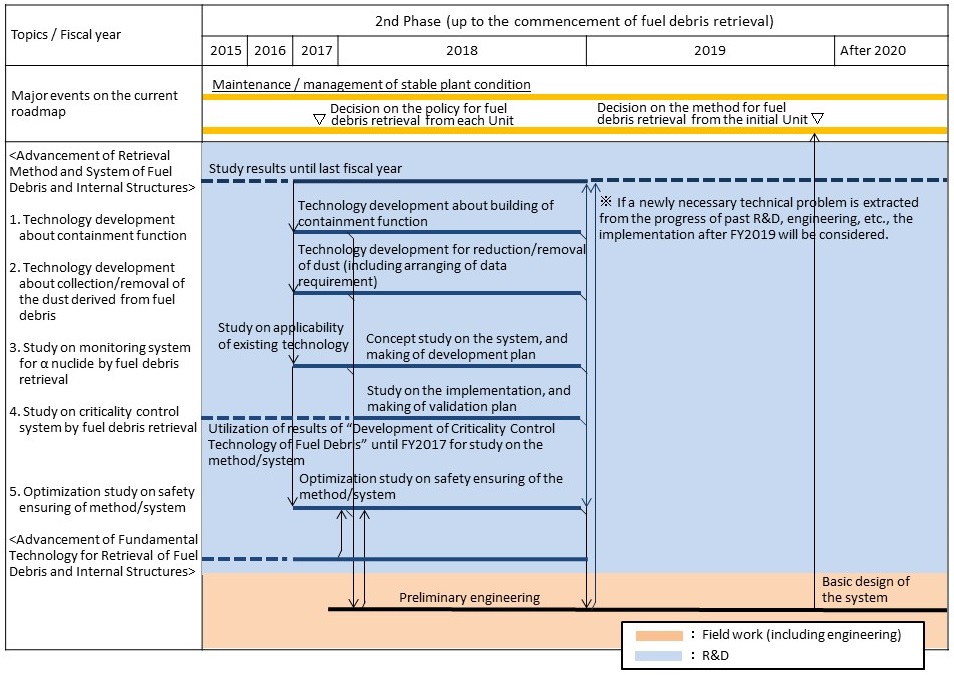
Source: Progress status of R&D projects and direction for next period
(METI, Secretariat of the Team for Countermeasures for Decommissioning and Contaminated Water Treatment (March 1, 2018)) (PDF page 9)
Results & performance by fiscal year
- FY 2018
- Status of progress at the end of February 2019 (METI, Secretariat of the Team for Countermeasures for Decommissioning and Contaminated Water Treatment (February 28, 2019)) (PDF page 22)
- Status of progress at the end of February 2019 (Development of Technology for Criticality Control in Fuel Debris Retrieval) (METI, Secretariat of the Team for Countermeasures for Decommissioning and Contaminated Water Treatment (February 28, 2019)) (PDF page 22)
- FY 2017
- FY 2017 result report (Advancement of Retrieval Method and System of Fuel Debris and Internal Structure (April 2018)) (IRID) (PDF)
- Status of progress at the end of February 2018 (METI, Secretariat of the Team for Countermeasures for Decommissioning and Contaminated Water Treatment (March 1, 2018)) (PDF page 19)
- FY 2016
- Completion report (Advancement of Retrieval Method and System of Fuel Debris and Internal Structure (March 2017)) (IRID) (PDF)
- Progress status at the end of February, 2017 (METI, Secretariat of the Team for Countermeasures for Decommissioning and Contaminated Water Treatment (February 23, 2017)) (PDF page 23)
- FY 2015
- Interim report (Advancement of Retrieval Method and System of Fuel Debris and Internal Structure (April 2016)) (IRID) (PDF)
- Progress status at the end of February, 2016 (METI, Secretariat of the Team for Countermeasures for Decommissioning and Contaminated Water Treatment (February 25, 2016)) (PDF page 39)
- FY 2014
Results & performance for individual projects, etc. (Archives)
Predecessor project (6): (1st stage) Upgrading Approach and System for Retrieval of Fuel Debris and Internal Structures (Project of Decommissioning and Contaminated Water Management)
Summary
We organized the most recent data and information related to conditions including plant information that is necessary to decide policies for retrieval of fuel debris and structures from reactors. We also studied feasibility of all three methods, including submersion method, submersion top-access method, and partial submersion side-access method, and maked conceptual designs for systems within the necessary scope. We also designed retrieval equipment and creating development plans for the three methods.
Action items
Predecessor project (7): Development of technology for retrieval of fuel debris and structures within reactors (Project of Decommissioning and Contaminated Water Management)
Summary
We have thoroughly looked at “all kinds of conditions and plant information” that is necessary to decide the method for retrieval of fuel debris and structures from reactors. We have also studied a wide range of scenarios and choices for fuel debris retrieval, and have organized the information and created appropriate formats, such as flow charts, for plans and decision criteria in order to make a final decision on the retrieval method for each plant.
Action items
Predecessor project (8): Advancement of Fundamental Technologies for Retrieval of Fuel Debris and Internal Structures (Project of Decommissioning and Contaminated Water Management)
Summary
We develop necessary elemental technologies based on past study results about retrieval method of fuel debris and internal structures. also, develop remote maintenance technology for retrieval equipment of fuel debris and internal structures.
Action items
Implementing organizations
Implemented by IRID, Hamamatsu Photonics, K.K., ONET Technologies CN(Comex Nucleaire), RosRAO, FSUE.
Implementation plan
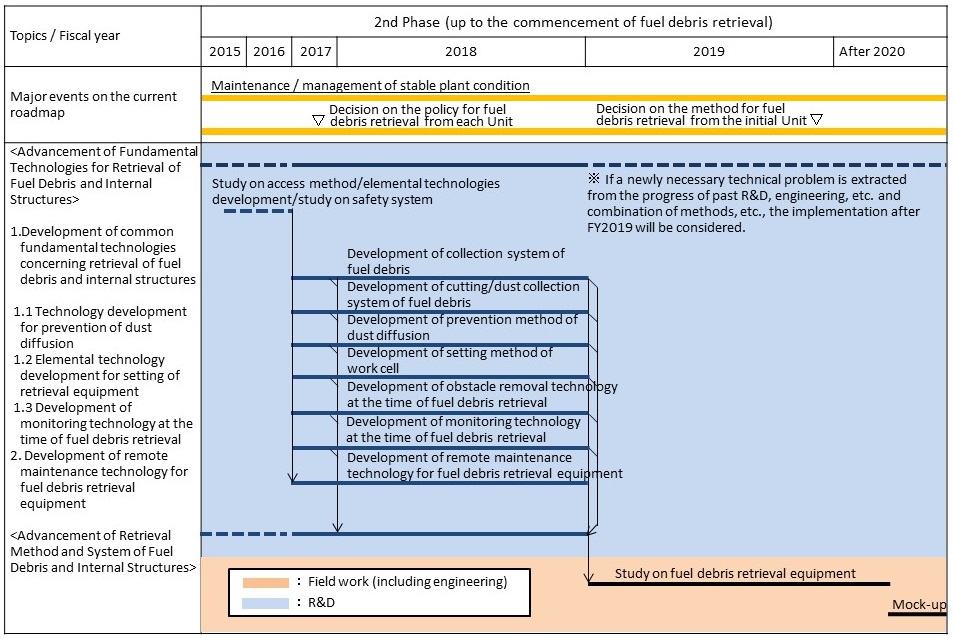
Source: Progress status of R&D projects and direction for next period
(METI, Secretariat of the Team for Countermeasures for Decommissioning and Contaminated Water Treatment (March 1, 2018)) (PDF page 11)
Results & performance by fiscal year
Predecessor project (9): Development of Fundamental Technologies for Retrieval of Fuel Debris and Internal Structures (Project of Decommissioning and Contaminated Water Management)
Summary
We developed and assessed the necessary component technologies in order to assess the feasibility of each of the three methods, the submersion method, the submersion-top accessmethod, and the partial submersion side-access method. This project was split between overall proposal businesses and partial proposal businesses, in which overall proposal businesses and partial proposal businesses conducted necessary component tests to ascertain feasibility of the methods, then overall proposal businesses performed overall organization of the component tests and analyzed results of component tests.
Action items
- Plant inspection in “Development of remote decontamination technology for use within buildings” (April 23, 2012) (TEPCO) (PDF)
- Condition setting to determine retrieval method policy
- Study on fuel debris retrieval method, system and equipment
- Feasibility study of method
- Conceptual study on system
- Design study on equipment
- Establishment of development plan for fuel debris retrieval system/ equipment
- Development of fuel debris sampling technology
- Setting all conditions for retrieval method policy decision
- Creating development plans, etc., for related component technology
- Investigation and study of existing technology
- Creation and updating of development plan
- Component tests and technology development
- Assessment of applicability to actual equipment, mockup tests
- Study of fuel debris retrieval method, system and equipment
- Development of common fundamental technologies concerning retrieval of fuel debris and internal structures
1.1 Technology development for prevention of dust diffusion- Development of collection system of fuel debris
- Development of cutting/dust collection system of fuel debris
- Development of prevention method of dust diffusion
- Development of setting method of work cell
- Development of obstacle removal technology at the time of fuel debris retrieval
- Development of remote maintenance technology for fuel debris retrieval equipment
- FY 2018
- Status of progress at the end of February 2019 (METI, Secretariat of the Team for Countermeasures for Decommissioning and Contaminated Water Treatment (February 28, 2019)) (PDF page 23-24)
- Status of progress at the end of February 2019 (Development of Small Neutron Detector) (METI, Secretariat of the Team for Countermeasures for Decommissioning and Contaminated Water Treatment (February 28, 2019)) (PDF page 25-26)
- Final report of phase 2 (Advancement of Fundamental Technologies for Retrieval of Fuel Debris and Internal Structures (Development of Small Neutron Detectors) (September 2018)) (RosRAO, FSUE) (PDF)
- Final report of phase 2 (Advancement of Fundamental Technologies for Retrieval of Fuel Debris and Internal Structures (Development of Small Neutron Detectors) (September 2018)) (IRID) (PDF)
- FY 2017
- FY 2017 result report (Advancement of Fundamental Technologies for Retrieval of Fuel Debris and Internal Structures (April 2018)) (IRID) (PDF)
- Summary Results of the Project of Decommissioning and Contaminated Water Management (March 23, 2018) (COMEX NUCLEAIRE) (PDF)
- Summary Results of the Project of Decommissioning and Contaminated Water Management (March 23, 2018) (TAISEI Corporation) (PDF)
- Summary Results of the Project of Decommissioning and Contaminated Water Management (March 23, 2018) (Hamamatsu Photonics K. K.) (PDF)
- Status of progress at the end of February 2018 (METI, Secretariat of the Team for Countermeasures for Decommissioning and Contaminated Water Treatment (March 1, 2018)) (PDF page 20-24)
- Completion report of phase 1 (Advancement of Fundamental Technologies for Retrieval of Fuel Debris and Internal Structures (Development of Small Neutron Detectors) (October 2017)) (RosRAO, FSUE) (PDF)
- Completion report of phase 1 (Advancement of Fundamental Technologies for Retrieval of Fuel Debris and Internal Structures (Development of Small Neutron Detectors) (October 2017)) (ONET Technologies CN) (PDF)
- Completion report of phase 1 (Advancement of Fundamental Technologies for Retrieval of Fuel Debris and Internal Structures (Development of Small Neutron Detectors) (October 2017)) (IRID) (PDF)
- Study on fuel debris retrieval method: “Reactor Pressure Vessel 1/1 Scale Model Test”, etc. (April 17, 2017) (IRID/Hitachi GE Nuclear Energy)
- FY 2016
- Development of “Flexible Structure Arm (Muscular Robot)” and remote operation technology for fuel debris retrieval (March 22, 2017) (IRID/Hitachi GE Nuclear Energy)
- Development of “Robot Arm / Access Rail”; testing of device for access inside the pedestal (March 21, 2017) (IRID/Mitsubishi Heavy Industries(MHI))
- Completion report (Advancement of Fundamental Technologies for Retrieval of Fuel Debris and Internal Structures (March 2017)) (IRID) (PDF)
- Progress status at the end of February, 2017(METI, Secretariat of the Team for Countermeasures for Decommissioning and Contaminated Water Treatment (February 23, 2017)) (PDF page 23 (IRID), page 28 (Hamamatsu Photonics, K.K./Taisei Corporation), page 29 (Comex Nucleaire))
- Development of “Laser Gouging Technology” for fuel debris (October 28, 2016) (IRID/Toshiba)
- FY 2015
- Component test required to assess feasibility of method
- Technology to prevent expansion of contamination during retrieval of large structures
- Technology to prevent expansion of contamination during fuel debris retrieval inside PCVs
- Technology for access to fuel debris
- Remote work technology for fuel debris retrieval
- Technology to prevent expansion of contamination during fuel debris retrieval
- Technology to reduce exposure for workers engaged in fuel debris retrieval
- Technology related to cutting and dust extraction during fuel debris retrieval
- Tests of monitoring technology during fuel debris retrieval
- Analysis of elemental test results
Completed projects
Development of Technologies for Fuel Debris Retrieval Gradually Expanded Its Scale (Project of Decommissioning and Contaminated Water Management)
Summary
Technologies for Fuel Debris Retrieval Gradually Expanded Its Scale shall be developed for the purpose to contribute to rationalization of criticality control, equipment design and works procedure related to fuel debris retrieval works and risk reduction of fuel debris by its retrieval.
Action items
- Development of Technologies for Fuel Debris Retrieval Gradually Expanded Its Scale
(1) Updating of the Development Plan of Retrieval Technology
(2) Development of Equipment and System for Retrieval.
① Test for Arm Functions Confirmation
② Combination test for Arm and Enclosure
③ Mock-up test
Implementation plan
Source: FY 2023 Research and Development Plan for Decommissioning
(METI, Secretariat of the Team for Countermeasures for Decommissioning and Contaminated Water Treatment (February 22, 2023)) (PDF page 2)
Results & performance by fiscal year
- FY 2022
- FY 2021
Switch button
Conceptual study of alternative fuel debris retrieval methods and study of feasibility of component technologies (Project of Decommissioning and Contaminated Water Management)
Summary
We did conceptual studies of open-air methods to retrieve fuel debris safely and surely. We also did feasibility studies of monitoring instruments with light, compact illumination functions that can be used for interior monitoring even in high-dose rate conditions, and of measurement instruments to identify fuel debris. Then we did feasibility studies of equipment that is capable of cutting fuel debris (including dust extraction functions).
Action items
- Conceptual study of alternative fuel debris retrieval methods
- Study of feasibility of monitoring and measurement technologies for alternative methods
- Study of feasibility of fuel debris cutting and dust extraction technologies for alternative methods
Implementing organizations
- Conceptual study of alternative fuel debris retrieval methods project
- IHI Corporation
- AREVA ATOX DA&D SOLUTIONS
- Cavendish Nuclear Ltd, BGE K.K., Shimizu Corporation
- Public Interest Incorporated Foundation Radwaste and Decommissioning Center, Kimura Chemical Plants Co., Ltd., General Incorporated Foundation Japan Clean Environment Promotion Organization
- Study of feasibility of monitoring and measurement technologies for alternative methods project
- QI Inc.
- Create Technologies Limited, Oliver Crispin Robotics Limited
- Hamamatsu Photonics, K.K.
- Fujikura Ltd.
- Study of feasibility of fuel debris cutting and dust extraction technologies for alternative methods project
- IHI Corporation
- ONET TECHNOLOGIES NUCLEAR DECOMMISSIONING OTND
- Taisei Corporation
Results & performance by fiscal year
- FY 2014
Results & performance for individual projects, etc. (Archives)
Switch button
- Conceptual study of alternative fuel debris retrieval methods
- IHI Corporation Report on results (PDF)
- AREVA ATOX DA&D SOLUTIONS K.K. Report on results (PDF)
- Cavendish Nuclear Ltd, BGE K.K., Shimizu Corporation Report on results (PDF)
- Public Interest Incorporated Foundation Radwaste and Decommissioning Center, Kimura Chemical Plants Co., Ltd., General Incorporated Foundation Japan Clean Environment Promotion Organization Report on results (PDF)
- Study of feasibility of monitoring and measurement technologies for alternative methods
- QI Inc. Report on results (PDF)
- Create Technologies Limited, Oliver Crispin Robotics Limited Report on results (PDF)
- Hamamatsu Photonics, K.K. Report on results (PDF)
- Fujikura Ltd. Report on results (PDF)
- Feasibility study for fuel debris cutting and dust extraction technologies in alternative methods
R&D efforts (related basic and generic research)
<Remote technology for inspections and measurements>
Inspection technology development (Decommissioning Basic Research : Human resource development program at Tohoku University - Basic research into reliability maintenance of PCV and buildings, etc., and waste processing and disposal, and core human resource development program for decommissioning)
Remote technology (Decommissioning Basic Research: Human resource development program at Tohoku University - Basic research into reliability maintenance of PCV and buildings, etc., and waste processing and disposal, and core human resource development program for decommissioning)
Research on remote operations technology (Decommissioning Basic Research: Human resource development program at University of Tokyo - Comprehensive human resource development for decommissioning based on remote operations technology and nuclide analysis technology) (PDF)
Remote measurement technology (Decommissioning Basic Research: Human resource development program at Tokyo Institute of Technology - Advancements in skilled human resource development for and basic research on decommissioning engineering) (PDF)
<Criticality control related>
Analysis of re-criticality accidents during debris retrieval (Decommissioning Basic Research: Human resource development program at Tokyo Institute of Technology - Advancements in skilled human resource development for and basic research on decommissioning engineering) (PDF)
Measures to ensure sub-criticality during debris retrieval (Decommissioning Basic Research: Human resource development program at Tokyo City University - Advancements in skilled human resource development for and basic research on decommissioning engineering) (PDF)
Plant investigation, measurement data, and information
Efforts to understand the plant status at each of Units 1 to 3, and for fuel debris retrieval (Updated October 7, 2025)
(METI, Secretariat of the Team for Countermeasures for Decommissioning and Contaminated Water Treatment)
- Current Status of Fukushima Daiichi NPS (As of July 31, 2025)
Plant-related parameters
- Plant-related parameters (Summary table) (PDF)
- Temperature parameters (Chart) Real-time data
- Unit 1 Temperature in the RPV (PDF)
- Unit 1 Temperature in the PCV (PDF)
- Unit 2 Temperature in the RPV (PDF)
- Unit 2 Temperature in the PCV (PDF)
- Unit 3 Temperature in the RPV (PDF)
- Unit 3 Temperature in the PCV (PDF)
- Fukushima Daiichi NPS plant data collected at the time of the accident (TEPCO)
- The Great East Japan Earthquake and Current Status of Nuclear Power Station(TEPCO)
- Outline of the plant (IRID) (PDF) only Japanese page
Fukushima Daiichi NPS survey map
Common data presented by Benchmark Study of the Accident at the Fukushima Daiichi Nuclear Power Plant (BSAF) related to accident progression analysis according to OECD/NEA
Information Portal for the Fukushima Daiichi Accident Analysis and Decommissioning Activities
Collection of figures of data on in-core situation (Updated regularly, August 2018)
Collection of links to data on in-core situation (Updated monthly, January 8, 2020)new
- Grasping of fuel debris Only Japanese(PDF)
- Stability of fuel debris Only Japanese(PDF)
- Operation safety Only Japanese(PDF)
- Retrieval of fuel debris and others Only Japanese(PDF)
Chronology (Events after the accident, in-core situation, etc.) (Updated regularly, September 2018)
- Chronology of Fukushima Daiichi NPS (Excel File)
Other related information
<Updated regularly>
